There are a variety of styles, configurations, and types of supported scaffolds with new designs and technologies being created every year. However, all supported scaffolds have several common safety concerns that must be addressed during their construction and use.
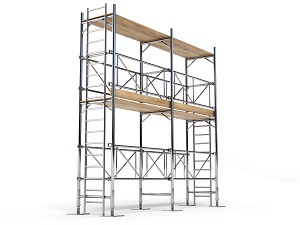
Found on nearly every construction project, scaffolds are extremely useful and can improve the efficiency at the job site by providing a safe and secure platform for workers. However, when scaffolds are constructed incorrectly, are missing key parts, or are used improperly, they can become a threat to worker safety.
Scaffolds are temporary structures that are subjected to repeated setup, teardown, and transport, often under rough conditions. Scaffolds have to be designed and manufactured to withstand not only this repeated abuse but also the stress of being loaded by heavy materials, equipment and workers.
The most common type of scaffolding is known as a supported scaffold and consists of one or more platforms supported by rigid supports like outrigger beams, brackets, poles, legs, uprights, posts, or frames.
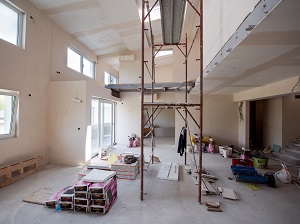
As with any construction, setup of a scaffold must start from a stable footing. If the foundation isn’t square and level then the scaffold will be at risk of collapse, and all workers working on or near the scaffolding will be at risk of injury.
Footings must be capable of supporting the loaded scaffold without settling or displacement. Unstable objects may not be used to support scaffolds or platform units. Front-end loaders and similar pieces of heavy equipment shall not be used to support scaffold platforms.
Supported scaffold poles, frames, uprights, etc. must be set on a base plate and mud sill or other firm foundation and must be plumb and braced to prevent swaying and displacement.
OSHA Standard 1926.451(c)(2) Supported scaffold poles, legs, posts, frames, and uprights shall bear on base plates and mud sills or other adequate firm foundation. (i) Footings shall be level, sound, rigid, and capable of supporting the loaded scaffold without settling or displacement.
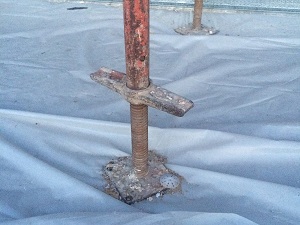
The platform is the main work area of the scaffold. It holds not only the workers, but also the materials, tools, and supplies necessary to get the job done. Scaffold platforms may be constructed using wooden planks, metal decks, or manufactured components.
Scaffold platforms must be fully decked in order to create a safe and stable work area. No gaps greater than 1 inch are permitted between adjacent planks or deck units, or between the platform and the uprights. Scaffold platforms and walkways must be at least 18 inches wide.
OSHA Standard 1926.451(b)(1) Each platform on all working levels of scaffolds shall be fully planked or decked between the front uprights and the guardrail support.
To prevent scaffold boards or planks from slippage, the platforms must be cleated or otherwise restrained at each end, or else overlap their support at least 6 inches. On scaffolds where platforms are overlapped to create a long platform, the overlap may only occur over supports, and may not be less than 12 inches, unless the platforms are restrained (nailed together) to prevent movement.
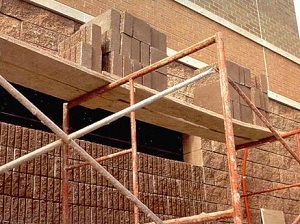
It is important that workers follow manufacturer’s instructions on how to avoid overloading and damaging the scaffold. Scaffolds and scaffold components must be capable of supporting, without failure, their own weight and at least 4 times their maximum intended load. Maximum intended load means the total load of all persons, equipment, tools, materials, transmitted loads, and other loads reasonably anticipated to be applied to a scaffold or scaffold component at any one time.
OSHA Standard 1926.451(f)(1) Scaffolds and scaffold components shall not be loaded in excess of their maximum intended loads or rated capacities, whichever is less.
The intended load will often be less than the rated load but should never exceed the rated load unless such design is approved by an engineer and the manufacturer. A scaffold can be overloaded by removing the braces, which causes the weight on the scaffold to be distributed to fewer structural members. Even if they are "in the way," braces should not be removed while work is being performed on a scaffold!
Scaffolds should never be modified or altered unless approved by the manufacturer and only under the supervision and direction of a competent person.

OSHA Standard 1926.451(e)(1) When scaffold platforms are more than 2 feet (0.6 m) above or below a point of access, portable ladders, hook-on ladders, attachable ladders, stair towers (scaffold stairways/towers), stairway-type ladders (such as ladder stands), ramps, walkways, integral prefabricated scaffold access, or direct access from another scaffold, structure, personnel hoist, or similar surface shall be used.
Workers must have a safe way to access their work areas when using a scaffold. Install a ladder or use a stairway-type ladder or walkway whenever there is more than 2 feet above or below a point of access to the scaffold. Never climb on the cross-braces or use them as a means of access to other levels of the scaffold.
Only use ladders that are specifically designed for use with the specific type of scaffolding. Position portable, hook-on, and attachable ladders so they do not tip the scaffold. Hook-on and attachable ladders must be positioned so that their bottom rung is not more than 24 inches above the supporting level.
Make sure that when scaffold stairways are used that the bottom step is not more than 24 inches above the supporting level. Use stairways that have slip-resistant treads on all steps and landings. When using scaffold stairways, they must have stair rail consisting of a top rail and a mid rail on each side of each scaffold stairway.
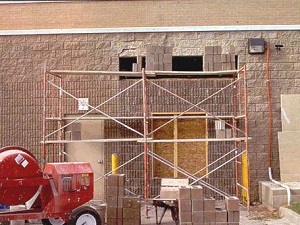
OSHA requires workers on scaffolds more than 10 feet above a lower level be protected from falling to that lower level. Fall protection consists of either personal fall arrest systems or guardrail systems meeting OSHA requirements. Workers performing overhand bricklaying operations must be protected from falling from all open sides and ends of the scaffold, except at the side next to the wall being laid.
OSHA Standard 1926.451(g)(1) Each employee on a scaffold more than 10 feet (3.1 m) above a lower level shall be protected from falling to that lower level.
All open sides and ends of scaffold platforms must be protected by a guardrail. Guardrails must be in place before the scaffold is released for use by workers other than those workers assembling or dismantling the scaffold.
A proper guardrail consists of a top rail, mid rail, and toe board and must meet these strength requirements applied in any downward or horizontal direction:
- Each top rail must withstand a force of at least 200 pounds.
- Mid rails, screens, mesh, intermediate vertical members, solid panels, etc., must withstand a force of at least 150 pounds.
- Toe boards must withstand a force of at least 50 pounds.
OSHA Standard 1926.451(g)(4)(i) Guardrail systems shall be installed along all open sides and ends of platforms. Guardrail systems shall be installed before the scaffold is released for use by employees other than the building or dismantling crews.
On supported scaffolds that use “x-braces” or cross-bracing workers may use the cross braces as either a top rail or a mid rail only if the crossing point is between 20 and 30 inches above the work platform for a mid rail or between 38 and 48 inches above the work platform for a top rail.
Never use steel or plastic banding as a top rail or mid rail. Ensure that guardrails have smooth surfaces to prevent punctures or lacerations to employees. Avoid using materials that could snag on clothing which may cause employees to lose their balance.
Toe boards are used for falling object protection and must be:
- at least 3½ inches high from the top edge to the level of the walking/working surface
- securely fastened in place at the outer edge of the decking
- not have more than ¼-inch clearance above the walking/working surface
- solid or with openings not over 1 inch
All workers on or near the supported scaffold must wear hard hats! Additional protection from falling hand tools, debris, and other small objects must be provided.
Where tools, materials, or equipment are piled to a height higher than the top edge of the toe board, paneling or screening extending from the toe board or platform to the top of the guardrail must be built for a distance sufficient to protect employees below. In some instances, the addition of debris nets, catch platforms, or canopy structures may be needed to contain or deflect potential falling objects.
OSHA Standard 1926.454(a) The employer shall have each employee who performs work while on a scaffold trained by a person qualified in the subject matter to recognize the hazards associated with the type of scaffold being used and to understand the procedures to control or minimize those hazards.
The area below the scaffold to which objects can fall may need to be barricaded to prevent workers and pedestrians from entering a hazardous area. If falling objects are too large or heavy to be contained or deflected, then those items must be secured and placed away from the edge.
Workers that are using, moving, assembling, or dismantling scaffolds must be properly trained. Training on scaffolds should include information such as:
- Correct procedures for assembling, disassembling, and using the specific type of scaffold on the project.
- Maximum intended load capacity and intended use of the scaffold.
- How to recognize the hazards associated with the type of scaffold being used.
- Proper use of the scaffold and the proper handling of materials on the scaffold.
- Steps for dealing with hazards such as electrical hazards, fall hazards, and falling object hazards.

.jpg)

